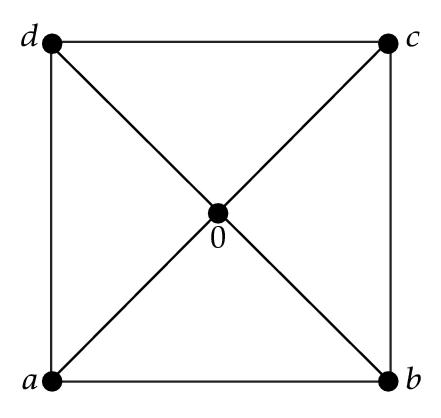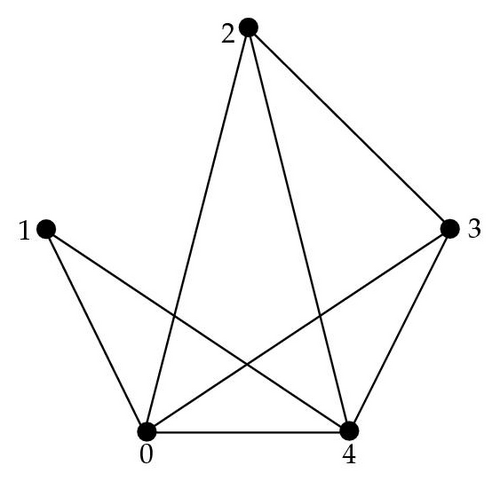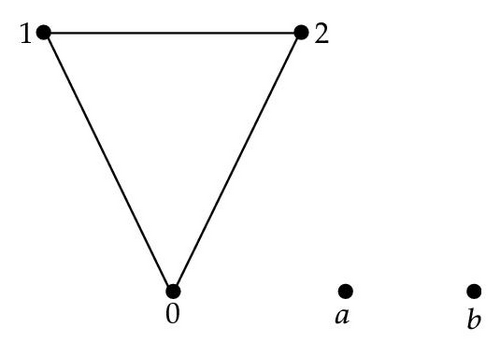Graphs Based on BCK/BCI-Algebras
Abstract
The associated graphs of BCK/BCI-algebras will be studied. To do so, the notions of (l-prime) quasi-ideals and zero divisors are first introduced and related properties are investigated. The concept of associative graph of a BCK/BCI-algebra is introduced, and several examples are displayed.
1. Introduction
Many authors studied the graph theory in connection with (commutative) semigroups and (commutative and noncommutative) rings as we can refer to references. For example, Beck [1] associated to any commutative ring R its zero-divisor graph G(R) whose vertices are the zero-divisors of R (including 0), with two vertices a, b joined by an edge in case ab = 0. Also, DeMeyer et al. [2] defined the zero-divisor graph of a commutative semigroup S with zero (0x = 0 ∀ x ∈ S).
In this paper, motivated by these works, we study the associated graphs of BCK/BCI-algebras. We first introduce the notions of (l-prime) quasi-ideals and zero divisors and investigated related properties. We introduce the concept of associative graph of a BCK/BCI-algebra and provide several examples. We give conditions for a proper (quasi-) ideal of a BCK/BCI-algebra to be l-prime. We show that the associative graph of a BCK-algebra is a connected graph in which every nonzero vertex is adjacent to 0, but the associative graph of a BCI-algebra is not connected by providing an example.
2. Preliminaries
- (I)
(∀x, y, z ∈ X) (((x*y)*(x*z))*(z*y) = 0),
- (II)
(∀x, y ∈ X) ((x*(x*y))*y = 0),
- (III)
(∀x ∈ X) (x*x = 0),
- (IV)
(∀x, y ∈ X) (x*y = 0, y*x = 0⇒ x = y).
- (V)
(∀x ∈ X) (0*x = 0),
- (a1)
(∀x ∈ X) (x*0 = x),
- (a2)
(∀x, y, z ∈ X) (x*y = 0⇒(x*z)*(y*z) = 0, (z*y)*(z*x) = 0),
- (a3)
(∀x, y, z ∈ X) ((x*y)*z = (x*z)*y),
- (a4)
(∀x, y, z ∈ X) (((x*z)*(y*z))*(x*y) = 0).
We can define a partial ordering ≤ on a BCK/BCI-algebra X by x ≤ y if and only if x*y = 0.
- (b1)
0 ∈ A,
- (b2)
(∀x, y ∈ X) (x*y ∈ A, y ∈ A⇒x ∈ A).
We refer the reader to the books [3, 4] for further information regarding BCK/BCI-algebras.
3. Associated Graphs
In what follows, let X denote a BCK/BCI-algebra unless otherwise specified.
Proposition 3.1. Let A and B be subsets of X, then
- (1)
A⊆l(r(A)) and A⊆r(l(A)),
- (2)
If A⊆B, then l(B)⊆l(A) and r(B)⊆r(A),
- (3)
l(A) = l(r(l(A))) and r(A) = r(l(r(A))).
Proof. Let a ∈ A and x ∈ l(A), then x*a = 0, and so a ∈ r(l(A)). This says that A⊆r(l(A)). Dually, A⊆l(r(A)). Hence, (1) is valid.
Assume that A⊆B and let x ∈ l(B), then x*b = 0 for all b ∈ B, which implies from A⊆B that x*b = 0 for all b ∈ A. Thus, x ∈ l(A), which shows that l(B)⊆l(A). Similarly, we have r(B)⊆r(A). Thus, (2) holds.
Using (1) and (2), we have l(r(l(A)))⊆l(A) and r(l(r(A)))⊆r(A). If we apply (1) to l(A) and r(A), then l(A)⊆l(r(l(A))) and r(A)⊆r(l(r(A))). Hence, l(A) = l(r(l(A))) and r(A) = r(l(r(A))).
Definition 3.2. A nonempty subset I of X is called a quasi-ideal of X if it satisfies
Example 3.3. Let X = {0, a, b, c, d} be a set with the *-operation given by Table 1, then (X; *, 0) is a BCK-algebra (see [4]). The set I : = {0, a, b} is a quasi-ideal of X.
Obviously, every quasi-ideal I of a BCK-algebra X contains the zero element 0. The following example shows that there exists a quasi-ideal I of a BCI-algebra X such that 0 ∉ I.
| * | 0 | a | b | c | d |
|---|---|---|---|---|---|
| 0 | 0 | 0 | 0 | 0 | 0 |
| a | a | 0 | 0 | 0 | 0 |
| b | b | a | 0 | a | 0 |
| c | c | a | a | 0 | 0 |
| d | d | b | a | b | 0 |
Example 3.4. Let X = {0, 1, a, b, c} be a set with the *-operation given by Table 2, then (X; *, 0) is a BCI-algebra (see [3]). The set I : = {0, 1, a} is a quasi-ideal of X containing the zero element 0, but the set J : = {a, b, c} is a quasi-ideal of X which does not contain the zero element 0.
Obviously, every ideal of X is a quasi-ideal of X, but the converse is not true. In fact, the quasi-ideal I : = {0, a, b} in Example 3.3 is not an ideal of X. Also, quasi-ideals I and J in Example 3.4 are not ideals of X.
| * | 0 | 1 | a | b | c |
|---|---|---|---|---|---|
| 0 | 0 | 0 | c | c | a |
| 1 | 1 | 0 | c | c | a |
| a | a | a | 0 | 0 | c |
| b | b | a | 1 | 0 | c |
| c | c | c | a | a | 0 |
Definition 3.5. A (quasi-) ideal I of X is said to be l-prime if it satisfies
- (i)
I is proper, that is, I ≠ X,
- (ii)
(∀x, y ∈ X) (l({x, y})⊆I⇒x ∈ I or y ∈ I).
Example 3.6. Consider the BCK-algebra X = {0, a, b, c, d} with the operation * which is given by the Table 3, then the set I = {0, a, c} is an l-prime ideal of X.
| * | 0 | a | b | c | d |
|---|---|---|---|---|---|
| 0 | 0 | 0 | 0 | 0 | 0 |
| a | a | 0 | a | 0 | 0 |
| b | b | b | 0 | b | 0 |
| c | c | a | c | 0 | a |
| d | d | d | d | d | 0 |
Theorem 3.7. A proper (quasi-) ideal I of X is l-prime if and only if it satisfies
Proof. Assume that I is an l-prime (quasi-) ideal of X. We proceed by induction on n. If n = 2, then the result is true. Suppose that the statement holds for n − 1. Let x1, …, xn ∈ X be such that l({x1, …, xn−1, xn})⊆I. If y ∈ l({x1, …, xn−1}), then l({y, xn})⊆l({x1, …, xn−1, xn})⊆I. Assume that xn ∉ I, then y ∈ I by the l-primeness of I, which shows that l({x1, …, xn−1})⊆I. Using the induction hypothesis, we conclude that xi ∈ I for some i ∈ {1, …, n − 1}. The converse is clear.
Lemma 3.8. If X is a BCK-algebra, then l({x, 0}) = {0} for all x ∈ X.
Proof. Let x ∈ X and a ∈ l({x, 0}), then a*x = 0 = a*0 = a, and so l({x, 0}) = {0} for all x ∈ X.
If X is a BCI-algebra, then Lemma 3.8 does not necessarily hold. In fact, let X = {0, 1,2, a, b} be a set with the *-operation given by Table 4, then (X; *, 0) is a BCI-algebra (see [4]). Note that l({x, 0}) = {0} for all x ∈ {1,2} and l({x, 0}) = ∅ for all x ∈ {a, b}.
| * | 0 | 1 | 2 | a | b |
|---|---|---|---|---|---|
| 0 | 0 | 0 | 0 | a | a |
| 1 | 1 | 0 | 1 | b | a |
| 2 | 2 | 2 | 0 | a | a |
| a | a | a | a | 0 | 0 |
| b | b | a | b | 1 | 0 |
Corollary 3.9. If X is a BCI-algebra, then l({x, 0}) = {0} for all x ∈ X with l({x, 0}) ≠ ∅.
Lemma 3.10. If X is a BCI-algebra, then l({x, 0}) = {0} for all x ∈ X+, where X+ is the BCK-part of X.
Proof. Straightforward.
Lemma 3.11. For any elements a and b of a BCK-algebra X, if a*b = 0, then l({a})⊆l({b}) and Zb⊆Za.
Proof. Assume that a*b = 0. Let x ∈ l({a}), then x*a = 0, and so
Theorem 3.12. For any element x of a BCK-algebra X, the set of zero divisors of x is a quasi-ideal of X containing the zero element 0. Moreover, if Zx is maximal in {Za∣a ∈ X, Za ≠ X}, then Zx is l-prime.
Proof. By Lemma 3.8, we have 0 ∈ Zx. Let a ∈ X and b ∈ Zx be such that a*b = 0. Using Lemma 3.11, we have
Definition 3.13. By the associated graph of a BCK/BCI-algebra X, denoted Γ(X), we mean the graph whose vertices are just the elements of X, and for distinct x, y ∈ Γ(X), there is an edge connecting x and y, denoted by x − y if and only if l({x, y}) = {0}.
Example 3.14. Let X = {0, a, b, c} be a set with the *-operation given by Table 5, then X is a BCK-algebra (see [4]). The associated graph Γ(X) of X is given by the Figure 1.
| * | 0 | a | b | c |
|---|---|---|---|---|
| 0 | 0 | 0 | 0 | 0 |
| a | a | 0 | a | a |
| b | b | b | 0 | b |
| c | c | c | c | 0 |

Example 3.15. Let X = {0, a, b, c, d} be a set with the *-operation given by Table 6, then X is a BCK-algebra (see [4]). By Lemma 3.8, each nonzero point is adjacent to 0. Note that l({a, b}) = l({a, d}) = l({b, c}) = l({c, d}) = {0}, l({a, c}) = {0, a}, and l({b, d}) = {0, b}. Hence the associated graph Γ(X) of X is given by the Figure 2.
| * | 0 | a | b | c | d |
|---|---|---|---|---|---|
| 0 | 0 | 0 | 0 | 0 | 0 |
| a | a | 0 | a | 0 | a |
| b | b | b | 0 | b | 0 |
| c | c | a | c | 0 | c |
| d | d | d | d | d | 0 |

Example 3.16. Let X = {0, 1,2, 3,4} be a set with the *-operation given by Table 7, then X is a BCK-algebra (see [4]). By Lemma 3.8, each nonzero point is adjacent to 0. Note that l({1,2}) = {0, 1}, that is, 1 is not adjacent to 2 and l({1,3}) = l({1,4}) = l({2,3}) = l({2,4}) = l({3,4}) = {0}. Hence, the associated graph Γ(X) of X is given by Figure 3.
| * | 0 | 1 | 2 | 3 | 4 |
|---|---|---|---|---|---|
| 0 | 0 | 0 | 0 | 0 | 0 |
| 1 | 1 | 0 | 0 | 1 | 1 |
| 2 | 2 | 1 | 0 | 2 | 2 |
| 3 | 3 | 3 | 3 | 0 | 3 |
| 4 | 4 | 4 | 4 | 4 | 0 |

Example 3.17. Consider a BCI-algebra X = {0, 1,2, a, b} with the *-operation given by Table 4, then

Theorem 3.18. Let Γ(X) be the associated graph of a BCK-algebra X. For any x, y ∈ Γ(X), if Zx and Zy are distinct l-prime quasi-ideals of X, then there is an edge connecting x and y.
Proof. It is sufficient to show that l({x, y}) = {0}. If l({x, y})≠{0}, then x ∉ Zy and y ∉ Zx. For any a ∈ Zx, we have l({x, a}) = {0}⊆Zy. Since Zy is l-prime, it follows that a ∈ Zy so that Zx⊆Zy. Similarly, Zy⊆Zx. Hence, Zx = Zy, which is a contradiction. Therefore, x is adjacent to y.
Theorem 3.19. The associated graph of a BCK-algebra is connected in which every nonzero vertex is adjacent to 0.
Proof. It follows from Lemma 3.8.
Example 3.17 shows that the associated graph of a proper BCI-algebra may not be connected.
4. Conclusions
We have introduced the associative graph of a BCK/BCI-algebra with several examples. We have shown that the associative graph of a BCK-algebra is connected, but the associative graph of a BCI-algebra is not connected.
Our future work is to study how to induce BCK/BCI-algebras from the given graph (with some additional conditions).




